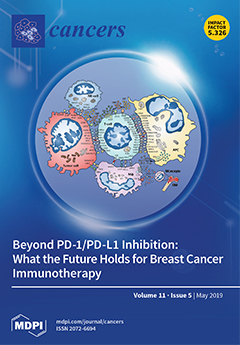Epithelial ovarian cancer (EOC) is the most lethal gynecological malignancy, with relapse occurring in about 70% of advanced cases with poor prognosis. Fluorine-18-2-fluoro-2-deoxy-d-glucose PET/CT (
18F-FDGPET/CT) is the most specific radiological imaging used to assess recurrence. Some intensity-based and volume-based PET parameters,
[...] Read more.
Epithelial ovarian cancer (EOC) is the most lethal gynecological malignancy, with relapse occurring in about 70% of advanced cases with poor prognosis. Fluorine-18-2-fluoro-2-deoxy-d-glucose PET/CT (
18F-FDGPET/CT) is the most specific radiological imaging used to assess recurrence. Some intensity-based and volume-based PET parameters, maximum standardized uptake values (SUV
max), metabolic tumor volume (MTV) and total lesion glycolysis (TLG), are indicated to have a correlation with treatment response. The aim of our study is to correlate these parameters with post relapse survival (PRS) and overall survival (OS) in Epithelial Ovarian Cancer (EOC) relapse. The study included 50 patients affected by EOC relapse who underwent
18F-FDGPET/CT before surgery. All imaging was reviewed and SUV
max, MTV and TLG were calculated and correlated to PRS and OS. PRS and OS were obtained from the first relapse and from the first diagnosis to the last follow up or death, respectively. SUV
max, MTV and TLG were tested in a univariate logistic regression analysis, only SUV
max demonstrated to be significantly associated to PRS and OS (
p = 0.005 and
p = 0.024 respectively). Multivariate analysis confirmed the results. We found a cut-off of SUV
max of 13 that defined worse or better survival (
p = 0.003). In the first relapse of EOC, SUV
max is correlated to PRS and OS, and when SUV
max is greater than 13, it is an unfavorable prognostic factor.
Full article






